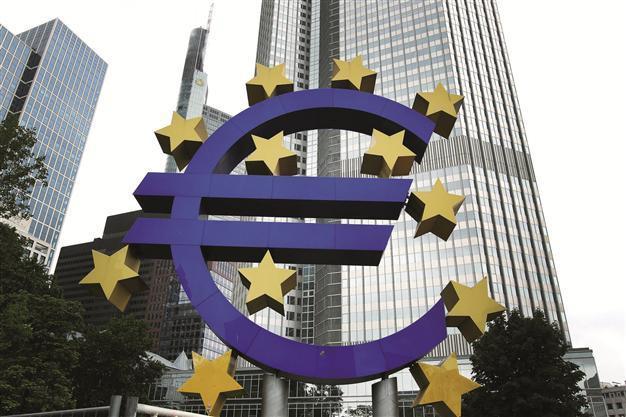ECB monitors impact of anti-deflationary steps
FRANKFURT - Agence France-Presse

The logo of the European currency is pictured in front of the European Central Bank ECB in Frankfurt. At its June meeting, the ECB entered uncharted waters, taking one of its key interest rates into negative territory for the first time. AFP photo
The European Central Bank (ECB) is unlikely to make new policy moves at its monthly meeting this week, focusing instead on monitoring the impact of last month’s unprecedented package of measures.After cutting rates last time round and pre-announcing new liquidity measures in its battle to prevent the single currency area from slipping into deflation, the ECB will “sit tight” at its meeting on July 3, central bank watchers predicted.
“The ECB is clearly going to sit tight for now at least while the interest rates and liquidity measures it announced at its June meeting increasingly kick in,” said Howard Archer at IHS Global Insight. “Indeed, a number of senior ECB policymakers have indicated that the bank is unlikely to act again in the near term at least, as it will take time for its recent announced package of measures to take full effect,” the expert continued.
At its June meeting, the ECB entered uncharted waters, taking one of its key interest rates into negative territory for the first time. It lowered its benchmark refinancing rate to 0.15 percent and cut the deposit rate, the rate at which the central bank pays commercial banks for depositing their unused cash, to minus 0.10 percent.
This means that banks will be charged for parking funds at the ECB, in the hope they might lend it on to businesses and consumers instead. ECB chief Mario Draghi also unveiled plans to pump more liquidity into the financial system later this year via the Targeted Long-Term Refinancing Operation (TLRTO). These are different to the liquidity measures it took at the end of 2011 and the beginning of 2012.
ECN has other possible measures
At that time, banks did not lend the cash on to the small and medium-sized companies that form the backbone of the eurozone economy and so this time, the ECB is targeting the loans to encourage banks to lend to households and non-financial corporations. With regard to further follow-up action, Draghi promised in early June that the ECB would “if required ... act swiftly with further monetary policy easing.”
But he admitted that in terms of interest rate cuts alone, there was no further room for action. “For all the practical purposes we have reached the lower bound,” he said. Analysts therefore believe the ECB has other possible measures up its sleeve, even so-called quantitative easing (QE), wide scale purchase of sovereign debt practiced by other central banks, but which the European bank has steered clear from imitating so far.
“The ECB has indicated that it is prepared to take further action if the risk of prolonged too low inflation morphing into deflation persists,” Archer at IHS Global Insight said. “And the ECB will likely want the market to keep thinking that further policy action is a very real possibility so as to keep downward pressure on the euro and market interest rates.”
Capital Economics economist Jennifer McKeown also believed that the ECB “is very unlikely to unveil additional policy support at its policy meeting on July 3 as it waits to judge the effect of the raft of measures announced in June.” She expected Draghi to reiterate that interest rates should be on hold for a long time yet.
















